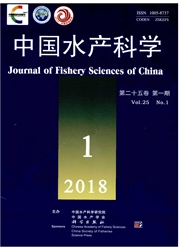

 中文摘要:
中文摘要:
本研究利用10对微卫星标记对菲律宾蛤仔(Ruditapes philippinarum)人工选育群体与野生群体进行遗传多样性分析。结果表明,每个位点的等位基因数为3~12个,期望杂合度范围为0.307~0.757,观测杂合度范围0.208~0.583。等位基因丰富度AR的大小范围是3.0~10.7,PCR扩增产物片段大小在178~390 bp,共得到63个等位基因,平均等位基因数范围从4.4(白蛤)到5.1(龙王塘野生群体),野生群体等位基因丰富度最大(5.278),白蛤群体的等位基因丰富度最小(4.267)。哈迪–温伯格检验发现4个群体和10对微卫星的40个组合中,有21个组合显著偏离哈迪–温伯格平衡状态。Kruskal-Wallis检验表明各个群体间的平均等位基因丰富度无显著差异。4个群体遗传分化系数F_(st)在0.086~0.180,遗传分化最大的是白斑马蛤群体与龙王塘野生群体(F_(st)=0.180),遗传分化最小的是白蛤群体和海洋橙群体(F_(st)=0.086)。人工选育群体表现为中度分化水平(F_(st):0.086~0.113);龙王塘野生群体与人工选育群体表现为较大分化水平(F_(st):0.134~0.180)。结果表明,人工选育群体的遗传多样性仍然比较高,但连续的选育对群体的遗传多样性和遗传分化有一定程度的影响。
 英文摘要:
英文摘要:
The Manila clam, Ruditapes philippinarum, which is widely distributed along the coasts of China, is an economically important marine bivalve species in China's aquaculture industry. The world production of this species was 3.6 million metric tons in 2010. As a country, China accounts for the largest proportion (-90%) of the total global pro- duction of Manila clams, producing about 3.0 million metric tons annually. This species includes several pedigree lines, such as White, Zebra, Liangdao Red, and Marine Red that are distributed in the coastal areas in North China. Microsatellite markers are a powerful tool because of their high level ofpolymorphism, stability, and co-dominance. As a result, they are used widely in studies of genetic diversity and population differentiation. In this study, 10 microsatellite mark- ers were analyzed.in three selected lines and one wild population ofRuditapes philippinarum. The number of alleles per locus ranged from 3 to 12, and allelic richness range was 3.0-10.7. Among all SSR loci, the mean number of alleles breeding populations of white zebra strain was 4.4. Allelic richness was lowest in the breeding white clam population (4.267). The average number of alleles and allelic richness was highest in the wild population from Longwangtang (5.100 and 5.278, respectively). There was no difference in average allelic richness among all groups (Kruskal-Wallis test, df=3, P=0.412). Expected heterozygosity ranged from 0.307 to 0.757, and observed heterozygosity ranged from 0.208 to 0.583. The 77.5% inbreeding coefficient (Fis) was positive, indicating that there is a certain level of inbreeding within populations, resulting in varying degrees of loss of heterozygosity. The Fst values between the three shell color strains ofR. philippinarum were between 0.05 and 0.15, indicating a moderate level of differentiation. The Fst values for comparisons between the Longwangtang population and the three shell colored lines were 0.15-0.25, indicating a greater level of differe
 同期刊论文项目
同期刊论文项目
 同项目期刊论文
同项目期刊论文
 期刊信息
期刊信息
